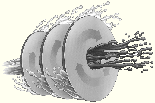


To keep up with increasing regulatory requirements, the Radioactive Liquid Waste Treatment Facility at the Los Alamos National Laboratory is replacing its 30-year-old system with an integrated membrane filtration system developed by SpinTek Systems of Huntington Beach, California. The system will be designed to treat the five to eight million gallons of radioactive liquid waste generated each year by research organizations within the LANL complex.
 As configured for use at LANL, the
membrane filtration system is a joint effort of LANL and SpinTek.
SpinTek developed and patented a cross-flow technology that
improves upon the conventional membrane process. The Morgantown
Energy Technology Center at Morgantown, West Virginia also played
a part in technology development efforts. METC administers the
Office of Science and Technology's Industry Program, through
which promising industry solutions to DOE environmental problems
are tested and scaled up. Spintek's proprietary centrifugal
microfilter, the heart of LANL's radioactive liquid waste system,
received funding through the technology-based development program
at METC.
As configured for use at LANL, the
membrane filtration system is a joint effort of LANL and SpinTek.
SpinTek developed and patented a cross-flow technology that
improves upon the conventional membrane process. The Morgantown
Energy Technology Center at Morgantown, West Virginia also played
a part in technology development efforts. METC administers the
Office of Science and Technology's Industry Program, through
which promising industry solutions to DOE environmental problems
are tested and scaled up. Spintek's proprietary centrifugal
microfilter, the heart of LANL's radioactive liquid waste system,
received funding through the technology-based development program
at METC.
Jerry Freer and Alan Bond, chemical engineers at LANL, have designed a solution to improve the effluent quality and reduce the volume of radioactive waste. This is the first time a centrifugal membrane filtration system will be used in the treatment of low-level radioactive waste. In this application, the filter combines ultrafiltration with centrifugal force to separate solids from liquid waste streams. The liquid waste is pumped into a cylindrical housing through a hollow shaft. Microporous membranes, arranged in flat disks, are attached to the shaft. The shaft spins at high speed, spreading the fluid across the membranes. Centrifugal force pulls the solid waste outward to the perimeter of the filter disks, where it is removed from the system. By pulling the solids outward, the centrifugal force keeps the filters clear so that the system can run continuously.
"Since the characteristics of our waste stream, a low-level radioactive, water-based matrix, can change on an hourly or daily basis, we secured a system that operates continuously," said Freer. "The SpinTek system allows continuous operation during changes in influent waste stream characteristics, which means zero downtime for flux recovery." After being pumped through the filter disks, the liquid exits through a collection shaft.
With the implementation of the new combined cross-flow and centrifugal filtration technology, Freer wants to achieve waste minimization by concentrating the low-level radioactive components of the waste stream. He set three system requirements: achieving a higher concentration factor over the current treatment, reducing chemical use, and providing high- quality effluent water for discharge.
The LANL engineering team researched other membrane systems before making their final decision to use the SpinTek system. As an example, a hollow fiber membrane system was tested and found to be incompatible with the Los Alamos waste stream, since it was only capable of concentrating the feed stream 10 times. "We experienced abrupt plugging and fouling problems with these membranes," Freer explained. "Operating hollow fibers continuously on our waste stream requires expensive pre-treatment and an automated back washing system, which means downtime."
In contrast, the SpinTek tubular membrane system reduced the feed stream by 70 times without fouling the membrane. The SpinTek centrifugal filter then further concentrates the waste up to 10,000 times to achieve a waste slurry of 30 percent solids. This higher level of solids will be achievable, because there is little or no significant fouling due to the high shear generated by the spinning membrane disks. The final component is a spiral-wound, reverse osmosis unit, which polishes the filtrate from both the tubular and centrifugal membrane systems and produces a suitable effluent for discharge, having only background levels of transuranic radionuclides.
The LANL facility will now be able to accomplish a concentration factor of 10,000 to one or greater. This contrasts to the existing treatment facility, a chemical precipitation and clarification system followed by filtration of low-level radioactive sludge, achieving a concentration factor of only 320 to one. The difference is due to the centrifugal membrane system's ability to concentrate up to 30 percent solids without the need of the clumping agents and filter aids currently in use that contribute to waste volume. "By increasing the concentration factor of sludge or radioactive waste, our new system will reduce the volume of secondary waste by 70 percent, a tremendous performance increase," said Freer.
Designed for high solids and viscosity feed streams, the SpinTek system has demonstrated an ability to operate reliably and consistently while producing a high solids radwaste slurry for disposal and a low-level effluent for discharge into the environment.
![]()
![]()
![]()